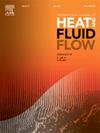基于拓扑优化的仿生雪花散热器设计得到了实验验证
IF 2.6
3区 工程技术
Q2 ENGINEERING, MECHANICAL
International Journal of Heat and Fluid Flow
Pub Date : 2025-06-04
DOI:10.1016/j.ijheatfluidflow.2025.109909
引用次数: 0
摘要
本文的目的是对模拟雪花的热汇拓扑结构进行温度场和流场的耦合拓扑优化,在尽可能降低压降的同时提高换热效率。利用平均温度和压降最小、温差和压降最小这两个多目标优化函数进行了伪三维拓扑优化,得到了两种不同的通道结构M1和M2。数值分析表明,拓扑优化后的通道M1和M2比传统的雪花直通式通道M3具有更好的热性能。与M3相比,M1和M2的热阻分别降低了27.5%和31.5%,温差分别降低了45.7%和52.4%。虽然压降略有增加,但热交换能力的显著提高证明了这一点。其中,M2的压降比M1的压降约低21.3%,是一种更优的设计。最后通过实验验证了数值模拟的准确性,温度的最大相对误差小于1.3%,压降的最大相对误差小于6.7%。本文章由计算机程序翻译,如有差异,请以英文原文为准。

A novel design of biomimetic snowflake heat sink by topology optimization verified by experiments
The purpose of this paper is to perform coupled topology optimization of the temperature field and flow field on the thermal sink topology of the imitated snowflake, aiming to reduce the pressure drop as much as possible while improving heat exchange efficiency. Two multi-objective optimization functions—minimizing both the average temperature and pressure drop, and minimizing both the temperature difference and pressure drop—were used in a pseudo-3D topology optimization, yielding two different channel structures, M1 and M2. Numerical analysis shows that the topology-optimized channels M1 and M2 offer better thermal performance than the conventional snowflake straight-through channel M3. Compared with M3, the thermal resistance of M1 and M2 was reduced by 27.5 % and 31.5 % respectively, while the temperature difference was reduced by 45.7 % and 52.4 % respectively. Although the pressure drop increased slightly, it is justified by the significant improvement in heat exchange capacity. Among them, the pressure drop of M2 is approximately 21.3 % lower than that of M1, making it the superior design. Finally, experiments were carried out to validate the accuracy of the numerical simulations, with the maximum relative error in temperature being less than 1.3 % and the maximum relative error in pressure drop less than 6.7 %.
求助全文
通过发布文献求助,成功后即可免费获取论文全文。
去求助
来源期刊

International Journal of Heat and Fluid Flow
工程技术-工程:机械
CiteScore
5.00
自引率
7.70%
发文量
131
审稿时长
33 days
期刊介绍:
The International Journal of Heat and Fluid Flow welcomes high-quality original contributions on experimental, computational, and physical aspects of convective heat transfer and fluid dynamics relevant to engineering or the environment, including multiphase and microscale flows.
Papers reporting the application of these disciplines to design and development, with emphasis on new technological fields, are also welcomed. Some of these new fields include microscale electronic and mechanical systems; medical and biological systems; and thermal and flow control in both the internal and external environment.
 求助内容:
求助内容: 应助结果提醒方式:
应助结果提醒方式:


